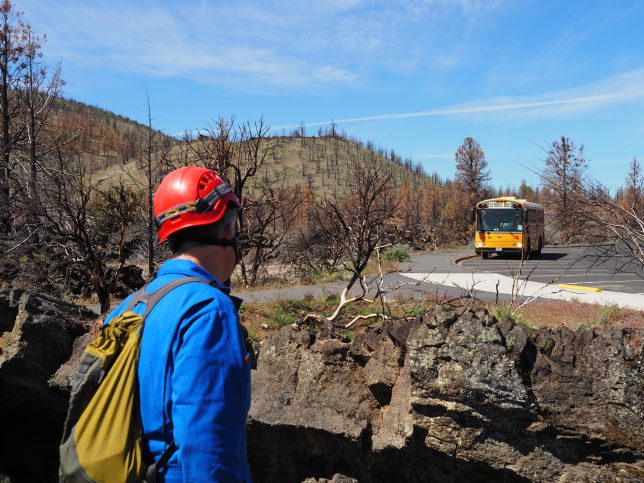By Ryan Kirby
The Many Faces of Science Communication
Science Communication (SciComm) can come in many forms, be it video, writing, graphics, personal dialog, or any other mode of communication. Communicating the science behind a project or field of science can range from making a small write-up about it to developing a large-scale video production on the likes of The Cosmos and everything in between. Understanding the audience, context, and purpose of the SciComm content you want to develop is crucial to determining what mode of communication you may want to use. For example, it may be easier for you to communicate how planets move around the sun to young children by using toy props to demonstrate or an animated video if you have a significant amount of time with them, while you may want to have attractive graphics or interesting pictures on fliers that show their orbits if you want them to have something to take with them. Similarly, the cute and colorful imagery that appeals to these children may not be the best approach for different groups.
From children’s books on quantum mechanics to simulation-like video games about settling on Mars, there are copious ways to communicate science topics to audiences of all ages. Of course, not all college students would be interested in reading said children’s book nor would many children get much out of trying such a video game because, again, understanding the audience that your SciComm project is geared toward is important to its success. Still, with the abundance of SciComm options at our disposal, it can be difficult to decide how to best communicate with your desired audience, even after you’ve identified them. We want to take you through our preparation and SciComm experiences during the May ‘22 field expedition to help give you an insight as to how we tackled this challenge.
Our Audience
We knew that we were going to be joined in the caves by two groups of middle school students during our first day on-site. Knowing this was helpful not just for our SciComm planning, but also for planning our experiment schedule. Since we wanted the students to be able to explore the caves and didn’t want our experiments interrupted, we opted to set up but not begin the experiments. This allowed the students to see the equipment (including the Spot robots!) and let us start up the experiments without too much wait once they left. It turned out that we would have over 30 visitors in each group, including teachers who monitored the students as they explored.

In addition to the students, we expected to be joined by smaller groups of visitors throughout the week since the park was still open to the public and our outfits drew a lot of attention, but we also planned on a Meet-and-Greet with one of the Spot robots near the end of the week, where the park staff and their families were invited to visit us at the research center. Lastly, we wanted to communicate with our followers on social media throughout the week as well; this group was naturally the hardest to predict what would best resonate with them since it consists of such a wide range of ages and backgrounds.
Deciding How to Reach Our Audience
Knowing our target audiences helped us prepare for our SciComm adventures significantly. We knew that our audience that would be physically joining us at the caves would largely consist of young students and families, meaning that we could gear our hands-on communication methods to be focused on these groups. This meant that we wanted to keep things short and simple but exciting and eye-catching, not heavily involved in the technical aspects of the robots or the mission. Having some background in graphic design, we hoped that this would prove to be one way to approach our audience; we wanted to use simplified graphics and short one-liners that would attract the attention of younger audiences. With this, we set out to do just that. We prepared many iterations of a vector art hand-drawn-style Spot robot until reaching two final designs, one with a boxy design and the other cartoony design. All of our final designs can be found on their respective page on our website, and are free to download!

Having two designs allowed us to be more flexible with how we delivered these designs to our audiences, now we just needed to decide how exactly we wanted to “deliver” this project to them. Luckily, once we decided on using graphic design in person, we already narrowed down our options to either having things hanging up and displayed around the caves and research center or making small items for them to take away. In an effort to not clutter our work area and the national park and to give our visitors something tangible they could remember the trip by, we landed on designing posters, small cards, and stickers to distribute on our trip.
We made several different designs for small cards so that everyone could take one that they liked with them. These ranged from a Spot robot on Mars to one peering out of a cave and looking toward the distant Moon. With these designs working well for our cards and posters, we just needed to make a more formal logo for our shirts and stickers. For this, we stuck with the simple design and used a hand-drawn-style Spot robot in a circular cave with “biological and resource analog investigations in low light environments” surrounding the design in a circle, reminiscent of an older design we used with the retired CaveR rover now replaced with a Spot robot. Short and simple, yet exciting and eye-catching.
SciComm in Action
Now that we had prepared well with our audience in mind, all that was left was to put all of this preparation work into action. When we arrived at the site, we prepared the first day to show the young students our designs, give them cards with their favorite graphics, and talk to them about the caves, robots, and astrobiology in general. Most of their questions were along the lines of “have you been to the Moon?” and “are you an astronaut?”, which were, if nothing else, fun and easy-to-answer questions.
We had other visitors throughout the week, including former team members, nation park workers, campers, cavers, and even the park superintendent, all of which adored both seeing the robots and having small tokens to take home, but there is one last part of our audience we couldn’t physically share these designs with, our online audience. Instead, we tried to communicate with them via pictures of our team members hard at work and videos of them explaining what they were working on. Some of these videos were exceptionally well received, reaching more views than any of our prior posts on the platform.
Overall, we found a lot of success in designing fun and eye-catching graphics for our younger in-person audiences to take home and going more in-depth videos about our project on our online platforms, where we were naturally found by more science-minded people.
